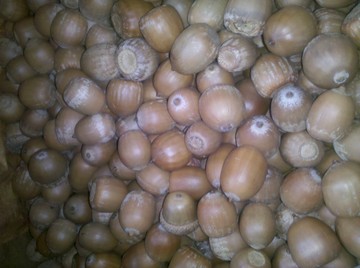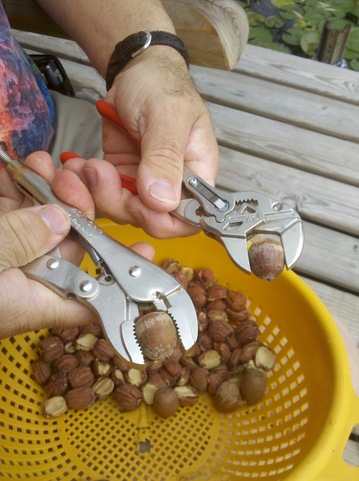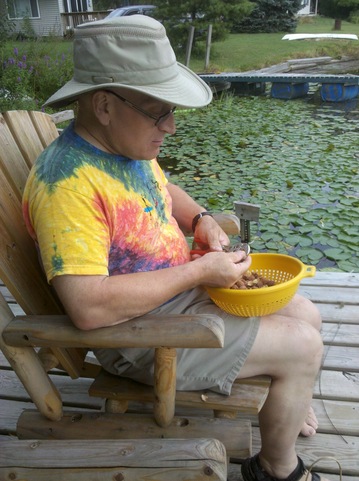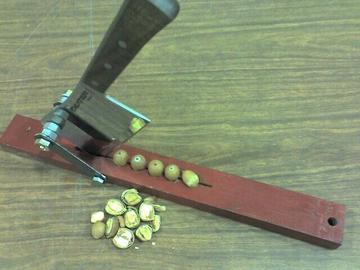Try some acorns at the HomeGrown Festival this Saturday

I was recently given an abundance of acorns, dried from last year and ready to be processed, then turned into tasty and nutritious food.
Linda Diane Feldt | Contributor
I’ve been rediscovering acorns lately. With the inspired assistance of my boyfriend, Tom, all sorts of possible uses of this fascinating food have been thoroughly discussed, explored, and implemented. A convergence of being given more acorns than I could possibly imagine with his tenacity and ingenuity in processing them has created a very interesting opportunity to experiment.
I write about acorns every year, and every year I learn more. Last year was a short article focusing on acorn flour, before that a bit of philosophy and the use of a toilet tank to flush tannins.
Part of what is fun about foraging and using unusual foods is discovering more, as well as learning how you were wrong or may have jumped to conclusions that don’t hold up with greater experience. Both are true as I’ve had more time to delve into acorns as food.
Previously I've been in awe that this food staple (an essential part of the diet for the people who lived in this area hundreds of years ago) has drifted into almost total non-use. Now, I'm discovering how versatile acorns can be.
I was certainly wrong about dried acorns. The processing is different, but not more difficult as I previously wrote. They lose some of the fresh nutty/fatty flavor, but drying also gives you time to open them as you can rather than rushing in the fall when everything else needs processing.
It is also far easier to flush tannins than I originally thought. Especially with acorns from white oaks, once they are ground and rinsed thoroughly a few time,s they are ready to be used or dried and frozen.
Right now, Tom and I are working our way through gallons of acorns I was given by someone who went to the trouble to dry them then didn’t have time to do the final processing. What a wonderful gift!
Tom created an easy to use cleaver to slice them open. We soon realized that for the dried acorns, using pliers actually works better to crack the shell, then peel it away to pop out the meat. Fresh acorns don’t “crack” in the same way, so the knife is best for the current crop just beginning to fall.

Locking pliers and pliers wrench, both helpful for opening dried acorn shells.
Linda Diane Feldt | Contributor
He is working on a rotary device with a hopper to feed in the nuts, but so far it is in the planning stages. For the dried nuts, he found a Knipex pliers wrench to be perfect for the task. I used my Vice Grips. With one setting it would crack most acorns,and then I could adjust it for smaller or larger.
Sitting peacefully cracking and shelling acorns together is a rather nice way to spend time. He has far more tenacity than I do. And he has also come up with some ways to eat acorn that I would never have imagined.

Linda Diane Feldt | Contributor
The ground then toasted acorn meat mixed with ground hazelnuts, chocolate, honey and cinnamon was a “wow!” A friend who tried it suggested it as a crust for a pear pie she was planning to make. Using toasted acorn meal as a topping for apple crisp (or any other fruit crisp) would be delightful.
With the dried acorns, roasting the meal helps bring back some of the full flavor lost by age. Careful stirring in a dry cast iron skillet over medium heat works well and only takes a few minutes.
We are planning to add acorn meal to butternut soup. It should add a lovely texture and accent to the sweet squash, a richness and fullness to make it a better soup.
Tom also mixed just plain toasted acorn meal with honey and cinnamon. While not nearly as fabulous as the hazelnut chocolate combo, it is interesting and enjoyable to nibble on. Adding a bit of dried fruit and some whole nuts, this would be great travel food and certainly reminiscent of how acorns were used hundreds of years ago.

A simple cleaver, purchased from Downtown Home and Garden, mounted on a small board to hold the acorns. This is perfect for opening fresh acorns, when the shells are still fairly pliable.
Tom Bowes | photo
The current method we’re using to process the acorns is pretty simple. We’re working our way through piles of acorns from white oaks. With red and black acorns, much more rinsing is involved. I’ve now heard from some foragers who say it isn’t worth the extra effort. I’m still taste testing before I decide.
-the dried acorn is cracked using pliers (fresh acorns are more easily sliced open with a sharp knife - see previous articles for details).
-the nut (or meat) is removed from the shell
-the meats are processed with water in a blender or food processor until coarsely ground
-the slurry is placed in a cheesecloth and tied or use a cheap nylon knee high stocking
-the slurry is rinsed thoroughly in fresh water (about a minute)
-squeezed dry, the mass is spread on cookie sheets
-the final drying is in the oven (200 degrees for about 8 hours, or in the sun for longer)
-when thoroughly dry store in air tight containers, in the freezer would be best
We’re mixing up these as well as more traditional recipes for the HomeGrown Festival Saturday, Sept. 10, at the farmer’s market. We’ll be demonstrating how to process the acorns, and we'll have the tools on display and also have some acorn products to sample. Please stop by and say hi! It promises to be a great event.
Linda Diane Feldt is a local Holistic Health Practitioner, teacher and writer. You can follow her on twitter, visit her website, or contact her directly ldf(at)lindadianefeldt.com She will be doing a food demonstration on wild foods featuring acorns at The Homegrown Festival Sept. 10, from 6-7:30 p.m..

